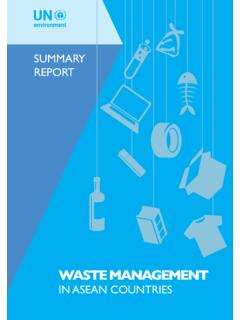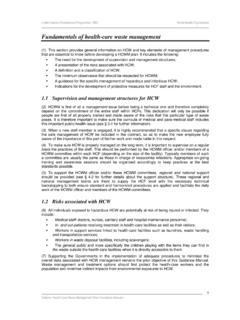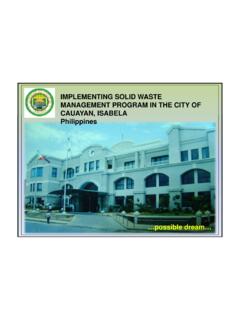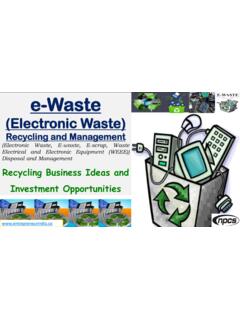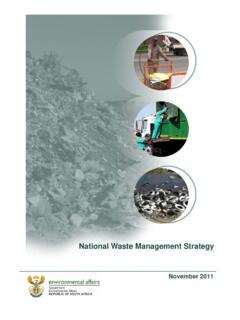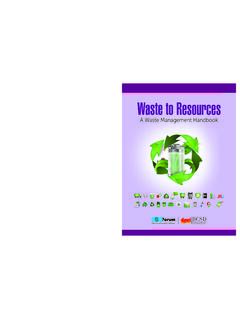Transcription of Waste Management Report - UAI
1 Waste ManagementDeveloped through a multi-stakeholder processfacilitated by:AccountingAdvertisingAluminiumAutomot iveAviationChemicalsCoalConstructionCons ulting EngineeringElectricity FertilizerFinance and InsuranceFood and DrinkInformation andCommunications TechnologyIron and SteelOil and GasRailwaysRefrigerationRoad TransportTourismWaste ManagementWater ManagementIndustry as a partner forsustainable developmentInternational Solid Waste Association (ISWA)Production Design by Beacon Creative+44 (0) 1825 768811 Printed by The Beacon Press using their environmental print technology that is both water andalcohol free. No film processing chemicals were used and 90% of the cleaning solvent was electricity was generated from renewable resources and vegetable based inks were to the environment Management system ISO14001 (Certificate No. ) and EMAS the EcoManagement and Audit Scheme (registration no. UK-S-00011), and the printer holds FSC Chain of Custodycertificate number SGS COC 0620.
2 Over 85% of any Waste associated with this product will be Report is released by the International Solid Waste Association (ISWA) and the UnitedNations Environment Programme. Unless otherwise stated, all the interpretation and findings setforth in this publication are those of the International Solid Waste Association (ISWA) The designations employed and the presentation of the material in this publication do not imply theexpression of any opinion whatsoever on the part of the International Solid Waste Association(ISWA) or the United Nations Environment Programme concerning the legal status of any country,territory, city or area or of its authorities, or concerning delimitation of its frontiers or contents of this volume do not necessarily reflect the views or policies of the United NationsEnvironment Programme, nor does citing of trade names or commercial processes publication may be reproduced in whole or in part and in any form for educational or non-profit purposes without special permission from the copyright holders, provided acknowledgementof the source is made.
3 The International Solid Waste Association (ISWA) and the United NationsEnvironment Programme would appreciate receiving a copy of any publication that uses thispublication as a published in the United Kingdom in 2002 International Solid Waste Association andUnited Nations Environment ProgrammeISBN: 92-807-2194-21A Report prepared by:International Solid Waste Association (ISWA)Overgaden Oven Vandet 48 EDK-1415 CopenhagenDenmarkTel:+45 32 96 15 88 Fax:+45 32 96 15 site: a multi-stakeholder consultation facilitated by the United Nations Environment Programme, anumber of groups (including representatives from non-governmental organisations, labour unions,research institutes and national governments) provided comments on a preliminary draft of thisreport prepared by the International Solid Waste Association (ISWA). The Report was then revised,benefiting from stakeholder perspectives and input. The views expressed in the Report remain thoseof the authors, and do not necessarily reflect the views of the United Nations EnvironmentProgramme or the individuals and organisations that participated in the ManagementIndustry as a partner for sustainable development2 Waste ManagementContents 35 Foreword9 Executive summary13 Part ISWA The International Solid Waste Scope of the report17 Part 2:Implementing the three dimensions of sustainable Environmentally sound Management of solid Description of the Waste Facts and figures on the municipal Waste Hazardous Waste management25 Part 3:Different approaches to Waste Management in different parts of the The European The United Other high and medium income Economically developing countries31 Part 4.
4 Implementation of sustainable development Waste Management and sustainable Waste Management today social Waste Management today economic Waste Management today environmental dimension39 Part 5:Means of Regulatory Market-based Economic Informative instruments49 Part 6:Future challenges and Key areas of progress Key areas for future Specific areas of Roles of other stakeholders54 Annexe 1:Case study 1: Sustainable development in example of good practice with regard to electronic scrap disposal56 Annexe 2:Case study 2: Waste Management in Metropolitan Cape TownA case study the challenges facing a developing city65 Annexe 3:Case study 3: Management of municipal solid wastes in China70 ReferencesContents4 ContentsList of figures20 Figure 1: Waste generation rates from 1960 to 1999 in the United States20 Figure 2:1999 total Waste generation in the United States21 Figure 3: Management of MSW in the United States21 Figure 4:Total Waste generation by sector EEA countries, 1992 to 199722 Figure 5:Is there still a correlation between economic growth and Waste generation?
5 22 Figure 6: Waste generation from daily household and commercial activities59 Figure 7:Desirability hierarchy in integrated Waste management60 Figure 8:Typical elements of a Waste Management systemTables:23 Table 1:Generation and transport of MSW in China28 Table 2:Statistics of MSW generation and transport in 11 large cities in China35 Table 3:Urban expenditure, total and on Waste , selected cities and yearsSince the 1992 World Summit in Rio deJaneiro, professional Waste Management hasmade significant technological and managerialcontributions to the protection of theenvironment. However, we are still facingnumerous and serious problems. The 1990scan be seen as a period of betterunderstanding regarding the position andfunction of the Waste Management sector asspecialist in the ecological, economic, and socialframework. The new decade offers anopportunity and at the same time shows thenecessity to proceed with theimplementation and consolidation ofenvironmental regulations.
6 Focused action isrequired as soon as possible, especially indeveloping document summarises contributions froma number of International Solid WasteAssociation (ISWA) national members. TheISWA is well aware of the fact that theoverview provided is far from being , the document clearly shows thesignificant change of the role of wastemanagement from the sector s limited scopeof dealing with wastes to the new task ofmanaging our society s Management has for quite some timebeen understood as a key area in globalenvironmental protection. Beyond thatintegrated Waste Management may beregarded as an interface between theproduction, distribution and consumption ofgoods on the one hand, and soil, groundwater,air and climate on the other. Thus, it is animportant partner in the context ofsustainable countries are currently fine-tuning their regulatory framework and wastemanagement infrastructure. The wastemanagement industry deals with considerablyrising environmental and legal standards, bestpractices, the need for increased efficiency,quality Management and occupational impact of Waste Management on theenvironment has been widely recognised inless developed regions, as well.
7 Getting controlof the various Waste streams from households,small shops, from the industry, the healthcaresector, and numerous other sources, allowstheir proper handling, treatment and , it has been recognised that verysimple solutions for Waste Management oftenhave tremendous effects on the health andsafety standards in developing collection is the basis for all subsequentmanagerial measures and treatmenttechnologies. The early stages we hope toenvisage comprise the establishment of a basicregulatory framework, of collection schemes,and of appropriate treatment and disposalfacilities to prevent further damage to theenvironment. Training of operators and staff isa key element in this context. Local operatorsand authorities can definitely benefitconsiderably from international support andthe transfer of know-how, so that they can runat least basic collection and recyclingoperations, landfills or compost plants in thebest possible way under the has recently entered into co-operationwith UNEP and is now able to offer trainingcourses in developing countries.
8 Furthermore,a special training pack for hazardous Waste isbeing developed in order to support thistraining programme. The tasks and challengeswe face today in our business and field ofresearch are the result of decades, if notcenturies, of economic and 5 ForewordOur behaviour as consumers, as well as ourroles as managers, operators or regulators, aredetermined by our specific set of values, ouremotions, our culture, our cognitivebackground, and by our personal degrees offreedom. Both education and legislation arerequired to change behavioural will create awareness and supportthe development of a new frame of mind in amid-term perspective. Legislation, however, hasto lay out the rules, to enforce them and toprevent violations as a short term view of the variety and complexity ofproducts and consequently of wastes, by-products, and residues, there is no singlesolution to the Waste treatment demands oftoday. An appropriate mix of technologies isneeded in order to meet the various technical,ecological and economic requirements ofintegrated Waste Management on a regionallevel.
9 As long as industry and consumersproduce Waste , we need an infrastructure thatallows for their proper treatment anddetoxification and for the safe long-termdisposal of residues. This system may becomeless extensive once we achieve good results inthe fields of Waste detoxification and concept of producer s responsibility wasrealised by shifting the financial burden for theproper treatment or recycling of end-of-lifeproducts to manufacturers. This has establisheda new line of communication between theenvironmental sector and managers relay information regardingthe design for recycling and the design fordisposal upstream to producers andmanufacturers, thus advocating the cause ofthe environment s capacities andenvironmental constraints. This communicationwill still be developed and further improved,but it can be regarded as a first step taken bythe Waste Management main challenges for the future are thetask of decoupling Waste generation fromeconomic growth by increased eco-efficiencyas well as the problems caused by the trend ofrapid urbanisation.
10 Given our presentproduction and consumption patterns, wastegeneration is closely tied up with populationgrowth and economic development. Many ofthe most rapidly growing conurbations andmega-cities are located in developing countrieswhere funding is still a critical issue. While theintroduction of fees for Waste collection andtreatment services raises people s awareness, itmay push consumers and businesses to illegalpractices. This makes education an even moreimportant factor in this , the Waste Management industry is wellaware of the importance of social include, among others the siting offacilities and the introduction of new collectionschemes, training workers and staff andeducating consumers, establishing andpromoting business, business relations andinternational dialogue, etc. Since the wastemanagement sector of today has a widerscope, an increased potential and a sense ofgrowing responsibility, it needs to create trustin its Management approaches, businesspractices and technical operation.

